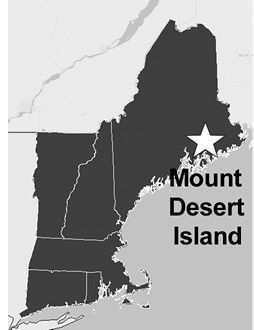Michael J. Good
 Human knowledge, language, deep understanding of natural history, and relationships with birds have existed for 10,000 years, easily traced back to ancestors of Maine’s Wabanaki people who discovered “Pemotonet” or Pemetic in Passamaquoddy (Neptune). Through traditional oral and written language, we understand that this “range of mountains” was vitally linked to human existence. Names for birds existed long before European settlement. Today, Pemetic is an Important Bird Area (IBA), home to Acadia National Park, and an economic driver for Maine’s ecotourism economy.
Human knowledge, language, deep understanding of natural history, and relationships with birds have existed for 10,000 years, easily traced back to ancestors of Maine’s Wabanaki people who discovered “Pemotonet” or Pemetic in Passamaquoddy (Neptune). Through traditional oral and written language, we understand that this “range of mountains” was vitally linked to human existence. Names for birds existed long before European settlement. Today, Pemetic is an Important Bird Area (IBA), home to Acadia National Park, and an economic driver for Maine’s ecotourism economy.
Roger Tory Peterson called Mount Desert Island (MDI) “the warbler capital of the world.” Peterson also suggested that birding on MDI can be difficult, because it is “necessary to be a bird listener as well as a bird watcher to recognize and fully appreciate the birds of Mount Desert Island.” (Harrison 1976) The famous James Bond, another noted ornithologist, summered on the western side of MDI and developed a number of checklists and bird pamphlets that have contributed to our deeper ornithological knowledge of MDI, including “Birds of Mt. Desert Island, Acadia National Park, Maine,” coauthored with Carroll Tyson (Tyson and Bond 1941).
This “Where to Go Birding” article is the third of a three-part series, “Birds of Acadia National Park and Mount Desert Island, Maine.” Following the seminal watershed work of Steve Perrin (1996), I continued the tradition of dividing Mount Desert Island into three major watershed drainage districts. “Part One: Eastern MDI,” covered hotspots in the watershed drainage district flowing east into Frenchman Bay, including Bar Harbor and Jordan Pond (Good 2022). “Part Two: Somes Sound, Central MDI” explored birding hotspots and the watersheds flowing centrally into Somes Sound (Good 2023). This article describes amazing places to bird in the watersheds flowing west into Blue Hill Bay, known as the quiet side of MDI.
To view the rest of the article you'll need to
subscribe. Bird Observer publishes original articles on birding locations, on avian populations and natural history, on regional rarities, field notes, field records, photographs, and art work.